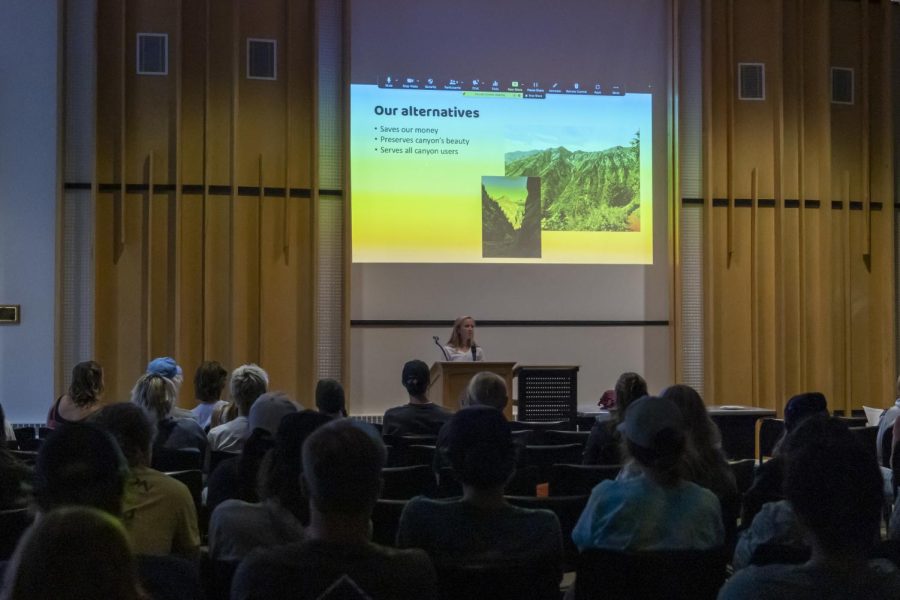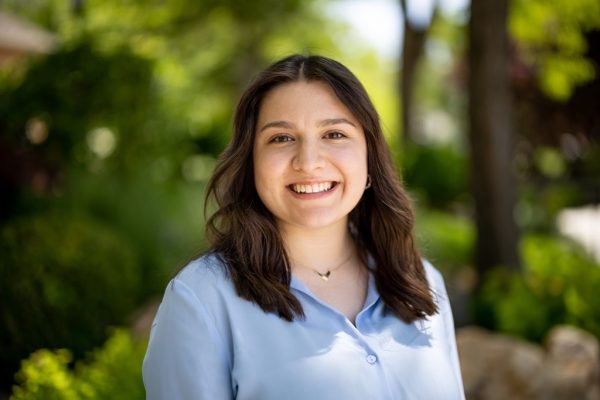Students for the Wasatch Hold Event to Discuss Solutions to Traffic Congestion in Little Cottonwood Canyon
Emily Pitsch, co-founder of Students for the Wasatch, presents during the event in the Union Theater on the University of Utah campus in Salt Lake City, Utah on Sept. 21, 2022. (Photo by Amen Koutowogbe | The Daily Utah Chronicle)
September 23, 2022
On Sept. 21, the University of Utah student-led group Students for the Wasatch held a public discussion about the potential construction of a gondola in Little Cottonwood Canyon.
In August, the Utah Department of Transportation selected Gondola B as the preferred alternative to widening state Route 210. According to the UDOT website, this decision was made, “as part of the Little Cottonwood Canyon Final Environmental Impact Statement (EIS) to improve transportation in the canyon.”
While UDOT has to wait for its next comment period to close, seek funding and have Utah State Legislature approval, Students for the Wasatch are taking action against building the gondola.
Finding Common Ground
“Tonight is really exciting because the conversation has never happened in the public where anti-gondola speaks to pro-gondola and we try to find common ground,” said Claudia Wiese, the co-president of Students for the Wasatch.
The public discussion forum started with a presentation from co-president Emily Pitsch about their stance on Gondola B.
“Our position is that we are opposed to the gondola but we are advocating for other solutions to improve traffic,” Pitsch said.
The estimated price of the gondola is $550 million. “It’s extremely expensive,” Pitsch said. She added that building the gondola would be “fiscally irresponsible.”
Other concerns of SFW’s are how construction would affect the sensitive watershed preserving the canyon’s natural beauty.
“UDOT also shows that their proposals for the canyon aim to get more users into the canyon instead of reducing the number of cars on the road,” Pitsch said.
SFW’s proposed alternative is an electric bus system.
“We would like to see an improved bus service ideally with electric buses,” Pitsch said.
Earlier this year, SFW took an electric bus from the Utah State Capitol through Little Cottonwood Canyon to advocate for an alternative to the gondola.
“It would also serve all canyon users because a bus can stop anywhere but a gondola would only stop at the resorts,” Pitsch said.
General Manager of Alta Ski Area Michael Maughan took to the stage to present their thoughts on the gondola. Maughan said both Alta and Snowbird resorts pay for their employees and all season pass holders to ride the bus for free.
“So that’s been our contribution from this industry to encourage bus ridership,” he said.
According to Maughan, finding employees to operate buses five to six months out of the year would be challenging. Recently, Alta added paid parking reservations to alleviate some of the traffic congestion.
“It was a positive thing,” he said. “We saw the reduction or change in the flow of traffic in the canyon.”
UDOT proposed two solutions to help Little Cottonwood Canyon: widening the road or building the gondola.
“Of the alternatives that were presented, we support the gondola,” Maughan said.
He said it is least impacted by weather, it has less environmental impact than the other options and it offers another method of transportation independent of the road. He acknowledged there would still be an environmental impact, but it would not be as impactful as widening the road or creating train stations.
Maughan then presented five interim solutions besides the gondola.
Their first solution was to propose a law requiring all Little Cottonwood Canyon visitors to have a four wheel drive vehicle with snow tires.
“I believe that just doing that would have more significant impact on reducing traffic congestion in the canyons than anything else,” Maughan said.
Their second solution was to minimize canyon closure times with remote address control devices. The current avalanche mitigation techniques create longer closures, but with this technology, “it takes us minutes to do what took an hour before,” Maughan said.
The next suggestion was to create shoulder space on the road for cars to queue up in order to prevent gridlock. During traffic delays, cars would queue up and join traffic as it begins to flow again.
Improving traffic merges for both Alta and Snowbird resorts is another solution.
“Maybe that roadside parking [at Snowbird resort] needs to be replaced somewhere else,” Maughan said.
Their last solution was to create a snow plow station at the top of the canyon.
“Someone could get that truck and plow the road before we start to slow the traffic down,” Maughan said.
Maughan said these solutions would cost significantly less than the gondola proposal.
At the end of the event, people were able to anonymously ask questions through an online forum. Some questions asked were about the cost of a gondola or bus ticket and the environmental impact of building the gondola.
While SFW and Alta may not have all the answers, they encouraged everyone to write to legislators and submit a comment to UDOT during their commenting period which closes on Oct. 17.
Students can find out more about this and upcoming events on the SFW Instagram page.









